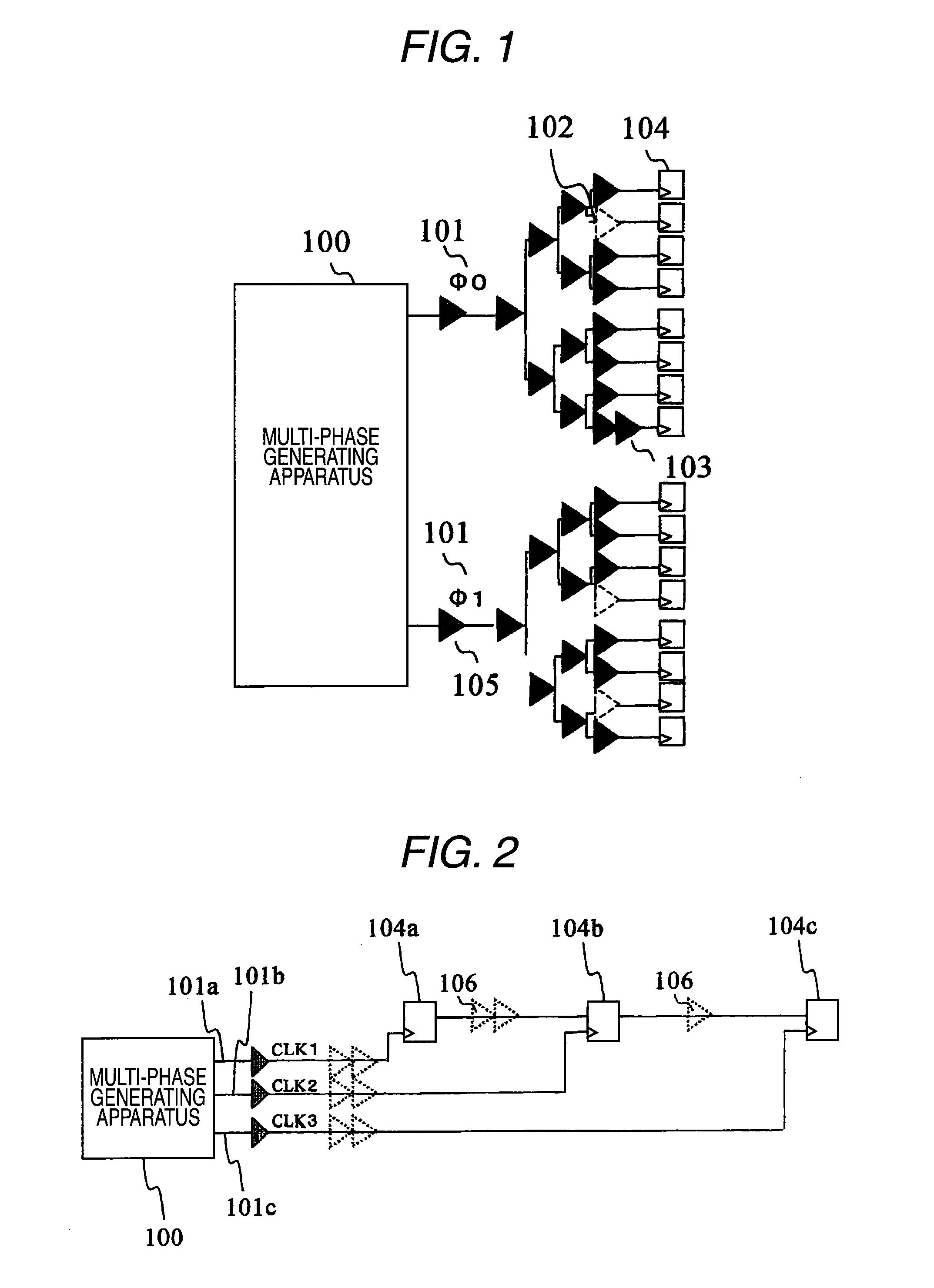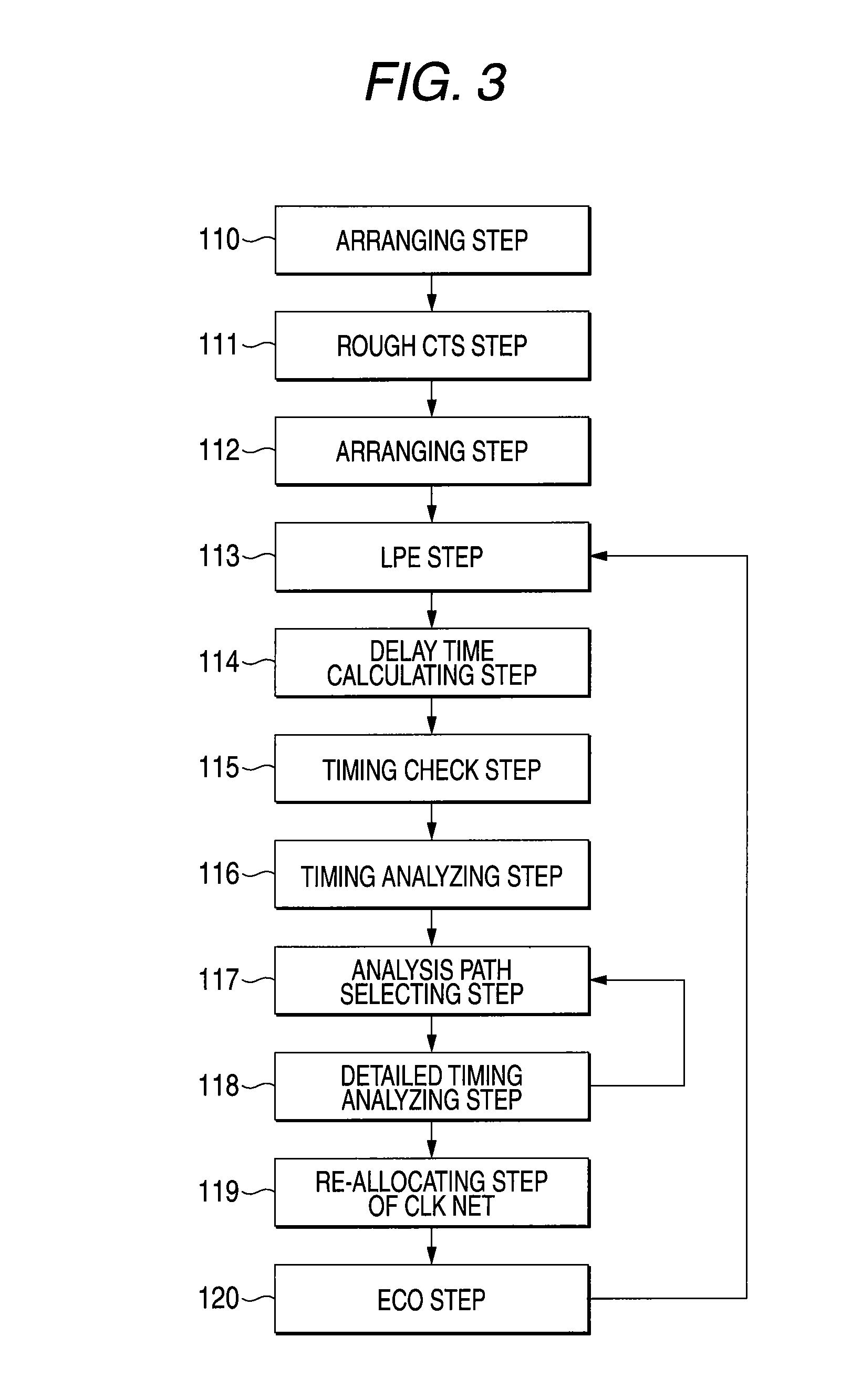Semiconductor device and method of designing semiconductor device
a semiconductor device and semiconductor technology, applied in the field of semiconductor devices, can solve the problems of omitting the step of providing delay buffers, useless function in the conventional design method, etc., and achieve the effects of reducing the development term, reducing the area, and reducing power consumption
- Summary
- Abstract
- Description
- Claims
- Application Information
AI Technical Summary
Benefits of technology
Problems solved by technology
Method used
Image
Examples
embodiment mode 1
[0046]A description is made of a method for designing a semiconductor device according to an embodiment mode 1 of the present invention. Firstly, a description is made of a clock tree which is employed in the method for designing the semiconductor device according to the embodiment mode 1. FIG. 1 is a diagram for showing a schematic structure of the clock tree which is employed in the method for designing the semiconductor device according to the embodiment mode 1. A multi-phase generating apparatus 100 shown in FIG. 1 is capable of supplying clock signals having a plurality of phases, and is used in order to supply clock signals having optimum phases within an adjustable range by considering propagation times on the data sides of flip-flops. The way for adjustments will be discussed later.
[0047]Reference numeral 101 indicated in FIG. 1 represents phases of plural clock signals which are supplied from the multi-phase generating apparatus 100. In addition to a method for adjusting a ...
embodiment mode 2
[0064]Next, a description is made of a method for designing a semiconductor device, according to an embodiment mode 2 of the present invention. It should be noted that the same reference numerals shown in the above-described embodiment mode 1 will be employed as those for denoting the same structural elements indicated in the embodiment mode 2, and therefore, detailed explanations thereof will be omitted. FIG. 6 is an explanatory diagram for explaining a reduction of peak power. FIG. 7 is a schematic structural diagram of the semiconductor device which is designed based upon the designing method of the embodiment mode 2. FIG. 8 show a relationship diagram between the semiconductor device of FIG. 7 and a regulator.
[0065]In FIG. 6, reference numeral 250 shows a peak current value as to an initial condition of a clock signal phase. Reference numeral 251 represents a distributed peak current value. In FIG. 7, reference numerals 252a, 252b, 252c, 252d, and 252e indicate flip-flops, respe...
embodiment mode 3
[0070]Next, a description is made of a method for designing a semiconductor device, according to an embodiment mode 3 of the present invention. It should be noted that the same reference numerals shown in the above-described embodiment mode 1 will be employed as those for denoting the same structural elements indicated in the embodiment mode 3, and therefore, detailed explanations thereof will be omitted.
[0071]FIG. 9 graphically represents all of timing “Slack.”FIG. 10 shows a schematic structural diagram of a semiconductor device which has been designed in accordance with the designing method of the embodiment mode 3. In FIG. 9, reference numeral 200 indicates timing checked values under the worst condition, namely, a left-sided timing checked value indicates a “margin”, whereas a right-sided timing checked value indicates a “violation.” Reference numeral 201 indicates timing checked values under the Typ condition, namely, a left-sided timing checked value indicates a “margin”, whe...
PUM
 Login to View More
Login to View More Abstract
Description
Claims
Application Information
 Login to View More
Login to View More - R&D
- Intellectual Property
- Life Sciences
- Materials
- Tech Scout
- Unparalleled Data Quality
- Higher Quality Content
- 60% Fewer Hallucinations
Browse by: Latest US Patents, China's latest patents, Technical Efficacy Thesaurus, Application Domain, Technology Topic, Popular Technical Reports.
© 2025 PatSnap. All rights reserved.Legal|Privacy policy|Modern Slavery Act Transparency Statement|Sitemap|About US| Contact US: help@patsnap.com



